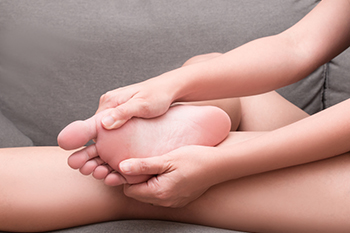Chronic Dull Pain Under Your Big Toe Joint
Tuesday, 15 February 2022 00:00Joints predominantly connect bones with each other. Sesamoid bones, however, do not connect to other bones; they are small, oval shaped bones embedded within tendons. Sesamoid bones are found in the knees and hands, and two are located underneath the big toe joint of the foot. This pair of hardworking sesamoids plays a vital role in bearing weight and movement. Sesamoids help the big toe move and push off forcefully when walking and running, and they act as shock absorbers for the long metatarsal bone in the forefoot that attaches to the big toe. Physical activities such as football, basketball, running, tennis and ballet can apply excessive pressure on the ball of the foot and cause various injuries to the sesamoids and surrounding tissue and tendons. Sesamoiditis is one such injury. Sesamoiditis is a chronic inflammation of the sesamoid bones and tendons that can produce a fluctuating dull pain under the big toe joint. There are several types of treatment—both conservative and surgical (if necessary)—that your podiatrist can go over with you if you are diagnosed with sesamoiditis.
Sesamoiditis is an unpleasant foot condition characterized by pain in the balls of the feet. If you think you’re struggling with sesamoiditis, contact Dr. Thomas Madden of Advanced Foot Care Center. Our doctor will treat your condition thoroughly and effectively.
Sesamoiditis
Sesamoiditis is a condition of the foot that affects the ball of the foot. It is more common in younger people than it is in older people. It can also occur with people who have begun a new exercise program, since their bodies are adjusting to the new physical regimen. Pain may also be caused by the inflammation of tendons surrounding the bones. It is important to seek treatment in its early stages because if you ignore the pain, this condition can lead to more serious problems such as severe irritation and bone fractures.
Causes of Sesamoiditis
- Sudden increase in activity
- Increase in physically strenuous movement without a proper warm up or build up
- Foot structure: those who have smaller, bonier feet or those with a high arch may be more susceptible
Treatment for sesamoiditis is non-invasive and simple. Doctors may recommend a strict rest period where the patient forgoes most physical activity. This will help give the patient time to heal their feet through limited activity. For serious cases, it is best to speak with your doctor to determine a treatment option that will help your specific needs.
If you have any questions please feel free to contact our office located in Killeen, TX . We offer the newest diagnostic and treatment technologies for all your foot and ankle needs.





